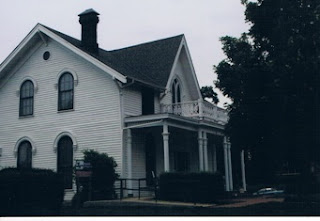You can collect diamonds the way Zsa Zsa did or you can
grab a bucket, a shovel and a saruca and head to Crater of Diamonds State Park near the town of Murfreesboro in
southwest Arkansas. The 37-acre diamond
field is the only diamond-producing area in the world open to the public.
The first diamonds were found here in 1906 by the owner
of the property. After his discovery,
John Huddleston sold his pig farm for $36,000 (nearly $1 million in today’s
dollars). Over the years the property
changed hands a number of times – usually with a disaster of some sort being
the catalyst for the change. Although
several spectacular and note-worth diamonds were found at the site, the diamond
mine was never a commercial success.
Finally, in 1972 the State of Arkansas purchased the property for a
state park.
You can bring your own shovels and other equipment for
diamond hunting or rent equipment at the park.
The three main techniques for discovering diamonds are surface
searching, dry sifting or wet sifting.
Surface searching was my preference since I have a short attention span
– I could wander around with a trowel and periodically dig up some lamproite. Mike tried both dry sifting and wet
sifting. The result? No diamonds from any of the prospecting
methods.
| The north "washing station", used for wet sifting |
| "Wet Sifting" |
| A saruca being used to "wet sift" for diamonds |
Others, though, have had much better luck.
* James Archer
of Nashville, AR, after retiring from his job, came to the diamond field six days each week for thirty years. He put seven children through college
with his diamond finds.
* Shirley Strawn of Murfreesboro, AR, discovered a diamond in 1990. It was
graded the highest diamond ever graded by the American Gemological Society,
a flawless, perfect diamond. Shirley named her diamond the Strawn-Wagner
Diamond, in honor of her great-great-grandfather, Lee Wagner.
* Lee Wagner, Shirley’s great-great-grandfather, had, himself, discovered a
very impressive diamond – a 17.86-carat yellow canary diamond that today
is on display at the Smithsonian.
* Less than two months ago, on July 31, twelve-year-old Michael, visiting the
park from North Carolina with his family, found a 5.16-carat diamond.
* Diamonds found the day we were there: none; the day before we were
there: 1; this year to date: 366; all of last year: 530.
| The diamond field is plowed every few weeks to help expose stones to hunters |
| This shovel and sign marks the exact location where the Amarillo Starlight diamond was found. At 16.37-carats, it is the largest diamond found since the site became a state park in 1972 |
If you don’t find your diamond in the Crater of Diamonds, it is possible to find one two miles north in the little town of Murfreesboro.
A visit to the Pawn King store can get you diamonds, or tools, or the owner’s favorite – guitars. (Regarding guitars, their brochure says “If it ain’t been in a pawn shop, it can’t play the blues.”) Or, for $3,500 – the price of a reasonably good diamond – you can be the proud owner of a six foot tall black bear. And in the spirit of “truth in advertising,” their brochure boasts “we cheat the other guy and pass the savings on to you.”
Another spot to shop for locally-discovered diamonds is Caddo’s Antiques. Graded and authenticated diamonds are available, most on consignment. The antiques in this shop are mostly glassware and china. The shop sells just about everything else from tons of Razorback gear to holiday décor. Two charming ladies sporting feathered hats are more than happy to help you.
| Caddo's Antiques |
| Get The Scoop Soda Shoppe |
So, on this Tuesday, no diamonds – but we did find several more good Road Stories.
http://www.craterofdiamondsstatepark.com/ Admission fee charged to enter
the diamond field and/or to
search for diamonds
Editor's Notes
Saruca Gem and Mineral Concentrator is a set of screens used for prospecting and mining gemstones and minerals, including rubies, sapphires, gold and diamonds.
Lamproite is a type of igneous rock. When this magma is ejected to the surface of the earth in a volcanic eruption it picks up fragmented materials from the mantle and crust and carries them along in its current. When the magma travels through diamondiferous regions of the Earth diamonds may become imbedded in the material
UPDATE UPDATE UPDATE Since we published this blog, a number of large diamonds have been found in the diamond fields. On Saturday, September 28, 2013, a 2.13-carat champagne diamond was unearthed, and on Saturday, October 19, 2013, 14-year-old Tanya Clymer of Oklahoma City found a 3.85-carat canary diamond after only two hours of searching. The yellow gem is teardrop-shaped and is about the size of a jelly bean. Perhaps Saturdays are the best days to search for diamonds!











